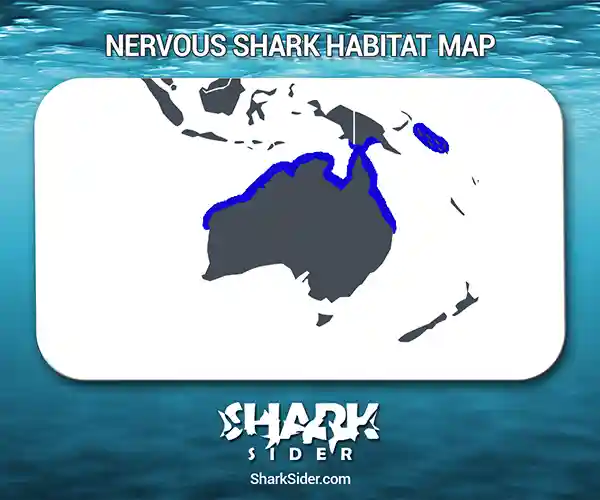The nervous shark is a requiem shark found in the southwestern Pacific Ocean.
Nervous Shark Scientific Classification |
|
| Kingdom | Animalia |
| Phylum | Chordata |
| Class | Chondrichthyes |
| Order | Carcharhiniformes |
| Family | Carcharhinidae |
| Genus | Carcharhinus |
| Scientific Name | C. cautus |
Description
Generally 3.3–4.3 ft long, the nervous shark can reach lengths of 4.9 ft, with females being larger than the males. They have a stubby snout shaped like a spindle and large eyes with nictitating membranes. There are 25-30 narrow, angled teeth in the upper jaws and 23-28 slender, upright teeth in the lower ones.
This shark has a set of pointed pectoral fins, a large sickle-shaped first dorsal fin, a second dorsal fin opposite the anal fin, and an asymmetrical caudal fin.
When looked at dorsally, these sharks are bronze to gray, while ventrally, it is white. There is a white stripe on their flanks and a thin black line along the margins of the fins.
Where do they live
Map Of The Nervous Shark’s Habitat

They live off the coasts of northern Australia, encompassing Shark Bay in the west and Moreton Bay in the east. These sharks are also seen around Papua New Guinea and the Solomon Islands.
Nervous sharks prefer mangroves with sandy-bottom areas, swimming in shallow waters up to depths of 148 ft.
Behavior
Hunting
These sharks feed on crustaceans like crabs and mantis shrimps, cephalopods, gastropods, and small teleost fishes like silversides and wrasses. Sometimes they will also hunt semi-aquatic snakes like the crab eating water snake and the bockadam snake.
Reproductive
Males bite the sides of the females before mating. After a gestation period of 11 months, they give live birth to a litter of 1-6 pups. The newborn sharks are 14–16 inches long and become sexually mature at 33-36 inches and 36-40 inches long for males and females, respectively.
The maximum lifespan of the nervous sharks tends to be 12-16 years, with the females living longer than the males.
Adaptations
Their counter-shading helps them camouflage themselves more effectively.
Interactions with humans
These sharks are wary of humans and avoid them if possible. This behavior of theirs earned them the name nervous shark. While they are susceptible to occasionally being fished up as bycatch, the IUCN lists the nervous shark as “Least Concern” or “LC”.
